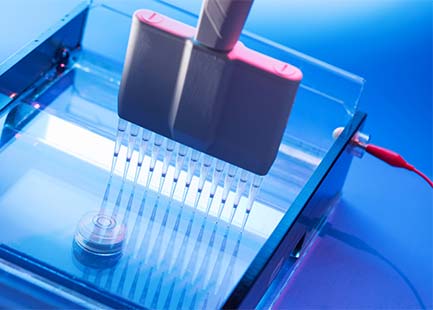Agarose gel electrophoresis is a common method for testing a gDNA or RNA isolation, for detecting PCR products, for checking a restriction digest and for DNA purification for subsequent cloning or sequencing.

Agarose is a polysaccharide consisting of the simple sugars D-galactose and 3,6-anhydro-L-galactose, which are glycosidically linked. Agarose is obtained from the cell wall of red algae and is particularly characterised by its strong gelling capacity. By boiling in a buffer solution, usually TAE or TBE buffer, the agarose powder dissolves and can then be poured into a gel. An agarose gel usually contains 0.5-3 % agarose, whereby a higher concentration means that the gel has smaller pores and is thus suitable for the separation of smaller nucleic acid fragments.
Our agaroses come in different purities, for different fragment sizes and with different gelling properties. Our low melt agaroses are particularly suitable for preparative electrophoresis, as the isolated DNA can be recovered very gently. Both TAE and TBE buffers are suitable as gel buffers. The TBE buffer is particularly characterised by its buffer capacity and is optimally suited for the separation of smaller DNA fragments. The TAE buffer, on the other hand, is better suited for the separation of large DNA fragments, as it heats up less during electrophoresis and thus a higher voltage can be applied.
Our chambers are made of robust acrylic glass and are available in different sizes for small and large sample quantities. The delivery includes the ordered electrophoresis unit with safety lid, a UV-transparent gel tray and a set of combs according to the number of comb positions. The chambers are easy to operate and there is a wide range of accessories and spare parts available, guaranteeing great user friendliness.
| Art.-Nr. | 2788.1 | 2799.1 | 2850.1 | 9398.1 | 9939.1 | 2941.1 | 3000.1 | 3099.1 |
| Type | PROfessional I | PROfessional II | PROfessional III | PROfessional III Stretch 20 | PROfessional III Stretch 25 | PROfessional IV | PROfessional V | PROfessional Acetat |
| L x W Gel | 7 x 7 cm | 10 x 10 cm | 15 x 15 cm | 20 x 15 cm | 25 x 15 cm | 20 x 20 cm | 32 x 26 cm | 20 x 24 cm |
| Max. number of samples | 32 | 80 | 210 | 280 | 350 | 500 | 672 | |
| Comb positions | 2 | 4 | 6 | 8 | 10 | 10 | 12 | |
| Buffer volume | 225 ml | 300 ml | 500 ml | 1000 ml | 1000 ml | 1200 ml | 1400 ml | |
| L x W x H device | 21 x 9 x 9 cm | 22 x 12.5 x 9 cm | 26.5 x 17.5 x 9 cm | 41 x 17.5 x 9 cm | 41 x 17.5 x 9 cm | 39.5 x 23 x 9 cm | 50 x 28 x 9 cm | 26.5 x 17.5 x 9 cm |
| Suitable for | Agarose | Agarose | Agarose | Agarose | Agarose | Agarose | Agarose | Acetat |
For the separation of nucleic acids in agarose gels, a running buffer is needed through which the current can flow, a loading dye to weigh down the sample and mark the running distance, and a DNA ladder for size estimation.
Our range includes TBE or TAE running buffers, in different concentrations, as buffer solution or in portion bags. The TBE buffer is characterised by its high buffer capacity. However, as there is a risk that the buffer heats up more during the run, a lower voltage should be selected. The TAE buffer, on the other hand, does not heat up that much and, since a higher voltage can be applied, is better suited for separating large DNA fragments.
Loading buffers and DNA markers are available in different compositions, specifically for running small, medium or large DNA fragments.
Probably the best-known fluorescent dye for staining DNA in agarose gels is ethidium bromide. Since ethidium bromide has mutagenic potential and is therefore suspected of causing cancer, there are now a number of non-toxic alternatives which can also be found in our assortment.
Apart from the fluorescent dyes, our range also includes a methylene blue staining concentrate, which reversibly stains the DNA and is visible in white light.
To transfer the nucleic acids, a suitable membrane, either nitrocellulose or nylon, a transfer buffer, blotting papers for capillary force and a semi-dry blotter are needed.
While in the Southern blot DNA fragments are transferred and examined, the Northern blot is used to transfer RNA. However, the transfer method remains the same. Our assortment includes all devices, buffers and reagents for the transfer of nucleic acids onto membranes.
Technical support
Our product management provides you with product, application and scientific advice on technical questions regarding our range of electrophoresis and will help you find the right product for your application.Phone: +49 721 5606 - 522
e-Mail: lifescience@carlroth.de

Mrs. Cairo